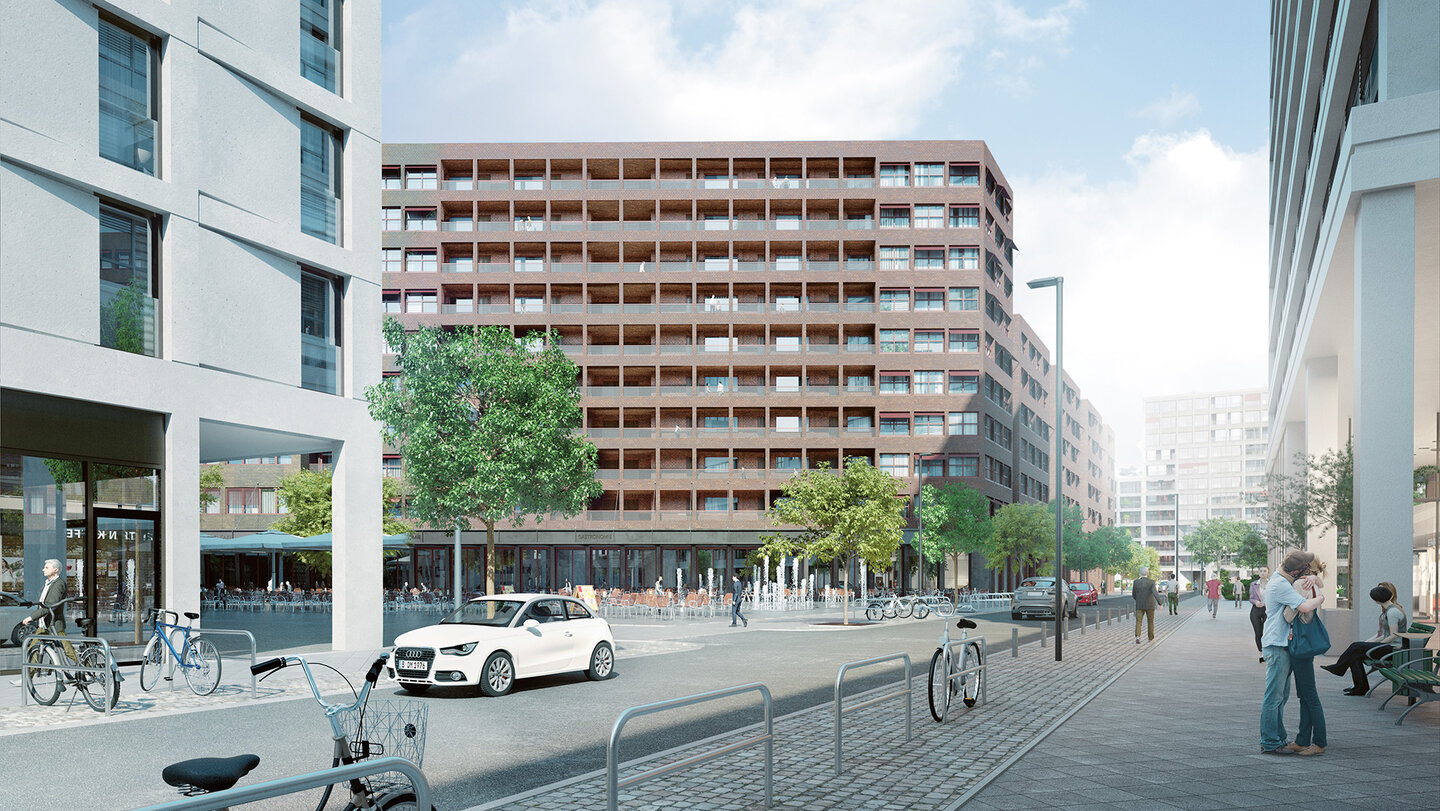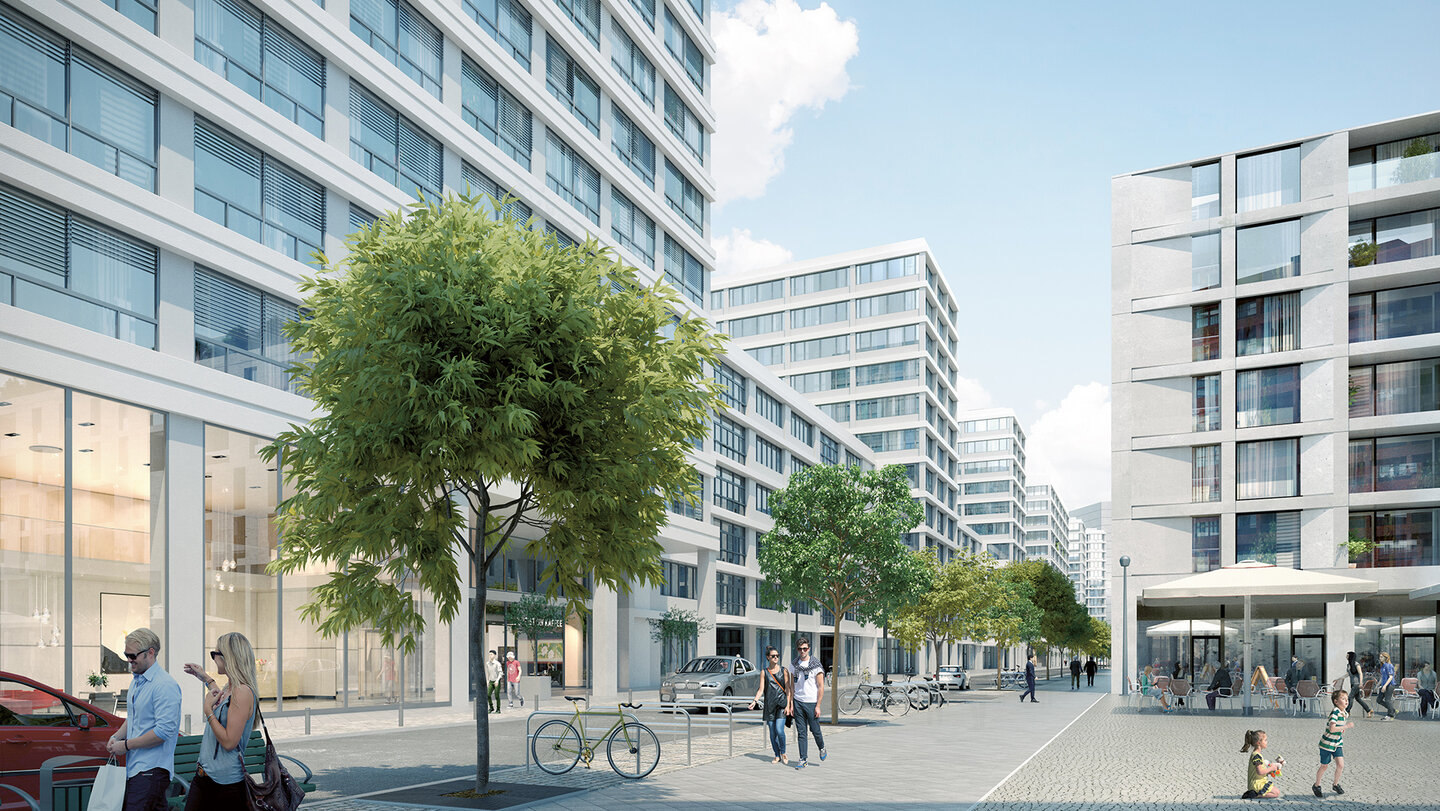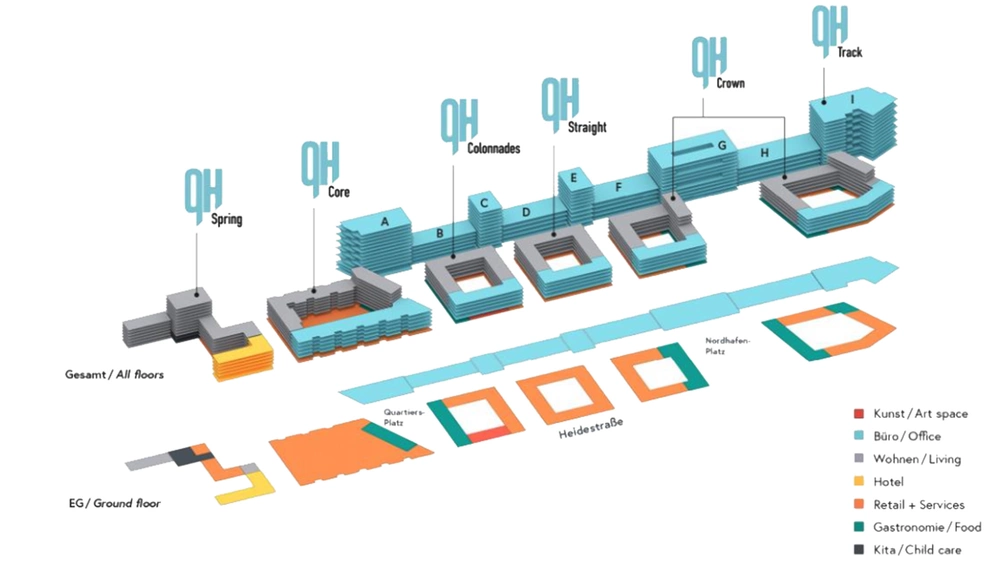Community-focused, flexible, smart and connected: Quartier Heidestrasse in Berlin is a forerunner of the smart urban district of the future. As well as being packed with technological innovations, it is designed to accommodate evolving lifestyles and new ways of working and getting around. It has made sustainability a central aspect of its design.
By Simon Dietzfelbinger, Partner and Head of Residential Properties at Drees & Sommer SE, and Sissi Al-Sheikh, Project Team Leader at Drees & Sommer
 © Quartier Heidestraße
© Quartier Heidestraße
At the heart of the European city of Berlin, the urban district of the future is taking shape. Quartier Heidestrasse incorporates energy-efficient construction methods, future-focused transport concepts, innovative parking management and comprehensive connectivity to facilitate a new kind of healthier, more sustainable and more digital urban lifestyle.
The new development is made up of a total of seven buildings on a plot of 85,000 m² and will provide space for a mixture of office, retail, food and hotel businesses, as well as 944 rental apartments. For decades, the area where it is being built was part of the no-man's land in between east and west Berlin and populated mainly by freight depots and warehouses. Today, because of its central location close to Berlin's central station, excellent local and national transport links and the tasteful regeneration of the area, it has become one of the city centre's most promising locations. With a mixed-use profile that consists of residential and office buildings, retail spaces, a kindergarten, public roads and squares, parks, cafes, restaurants and a central convenience store at the heart of the project, Quartier Heidestrasse is currently the largest development in the German capital city. It is due to be fully finished by 2023.
The landowner is Quartier Heidestrasse GmbH, which is represented by Taurecon Real Estate Consulting GmbH as the construction site manager and project developer. Drees & Sommer has also been working on the project since 2014, with the goal of creating a vibrant and future-facing district that connects users beyond their apartments and office spaces and opens up a new digital dimension of life. Digitization experts at the company are coming up with a system that connects the entire district and covers a wide range of applications and user groups.

Quartier Heidestrasse is a sign of things to come
Entry into the office buildings is controlled digitally. App-based space utilization systems help organize office spaces. Meanwhile, heating, ventilation, blinds and other features are controlled automatically, both in the office and residential parts of the development. The Quartier app will not only enable neighbours to communicate but will also inform users about service offers. It can also do things like show energy consumption, enable communal facilities to be booked and dispense tickets for feedback and complaints. Post rooms will alert users via the app that a parcel has arrived and lifts will be called automatically when people leave their flat or enter the building.

Quartier Heidestrasse is a transport pioneer – offering the closest routes to local amenities and electric buses and enabling parking to be managed through the app. The app can also react to individual needs like parking duration, car size or advance bookings whilst directing people looking for a parking space to the closest available spot. Even car-sharing companies can be integrated into the app.
On the one hand, the Berlin development is a trailblazer for the architecture and technology of the future. On the other, it also serves as an inspiration to investors, project developers, proprietors and operators. If the property boom is over, the question has to be asked whether planned buildings, projects or existing properties are modern enough to be fully occupied in the next few years – and whether renters' increasing digital requirements can be met with the existing digital infrastructure. And lastly, opportunities need to be identified to offset lost income from developments. We already know that, in the medium to long term, this will only be achieved through eco-friendly and efficient buildings.
Properly planned mixed-use developments: where different spheres of life overlap
Whether you're a landlord or tenant, resident or commercial user, everyone wants to combine the different parts of their lives in the best way possible.
Everyone wants to travel short distances, have the best mobility and transport services on their doorstep and as much flexibility as possible. Everyone enjoys being part of a community and being more sustainable – yet they aren't quite ready to do without technology and digital innovations. For a district or entire town to thrive in the future, it's important that people enjoy being there and that their needs can be met as sustainably as possible.
The way to meet these requirements in the long term is through mixed-use developments where housing, offices, retail, restaurants and leisure facilities are closely intertwined. However, it's not simply enough to put these different buildings adjacent to one another. Rather, it's about creating synergies and adding value by combining a wide range of applications and integrating aspects such as energy, climate, resources, mobility, infrastructure, digitization, finances and society. The driving principle in the future will be only using what you need: for example, a person renting an apartment won't need a study anymore if they can book into a neighbouring co-working space (if that's the appropriate work environment). Or an unused parking place could be taken up by others. Or moving to a digital concierge, which would increase comfort and flexibility.

Quartier Heidestrasse is an impressive example of what can be done. It combines a well-thought-out mixture of uses and smart building management with a kind of architecture that gives residents and users a general sense of well-being. A block of flats made of bricks sits next door to a mixed-use residential and commercial complex with a natural concrete façade and an inner courtyard filled with plants. QH Spring sets an early architectural benchmark with its 3-dimensional concrete facade filled with intricate metal detailing and eye-catching large windows. With the first tenants due to move in at the end of 2021, the building comprises a hotel, a kindergarten, commercial units and a 12-storey block of flats.
Taurecon Real Estate Consulting has worked together with Drees & Sommer and its collection of promising PropTechs and service providers to develop innovative ideas and technology-based approaches that will ensure that Quartier Heidestrasse has the digital and sustainable solutions for long-term success. Community-based and green, flexible and smartly connected – these are the qualities that make Quartier Heidestrasse a true pioneer.
Simon Dietzfelbinger: Partner at Drees & Sommer SE
Simon Dietzfelbinger is Partner and Head of Residential Properties at Drees & Sommer. He studied industrial engineering at the University of Leipzig with a specialization in the construction industry and joined the company in 2009. His work focuses on residential construction and urban planning and the management and supervision of large-scale projects. In addition, he is involved in developing the areas of digitization and innovative business models in the residential construction sector. As an experienced project manager, Simon has extensive knowledge and expertise across all phases of a project – from the initial idea through to completion. Aside from Quartier Heidestrasse, some other projects he has worked on are the Fünf Morgen Dahlem Urban Village and Carossa Quartier, all of which are in Berlin.
Sissi Al-Sheikh: Project Team Leader at Drees & Sommer
Sissi Al-Sheikh is a Project Team Leader at Drees & Sommer’s Berlin office and is responsible for lean construction management and project management for the 8,500-desk office project in the QH Trackdas area of the Quartier Heidestrasse district. As the main point of contact on the project management side of things, she oversees everything from site development and planning to site supervision and creating a comprehensive lean and digital solution for the area. After completing her studies in industrial engineering with a civil engineering module at the Technischen Universität Berlin and living in Arab Emirates, she joined Drees & Sommer in 2015 to work at its Berlin office.

The corona pandemic has accelerated many developments that would have come to the real estate industry sooner or later anyway - especially with regard to digitalisation and sustainability. One thing is certain: offices will continue to exist, they will have to exist. What distinguishes them, which aspects will be important for the workplace in the future and for everyone connected with it, is the subject of numerous articles and interviews in our dossier "The Workplace Reloaded".